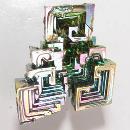|
|
||||||||||||||||
|
||||||||||||||||
|
||||||
|
|
|
|
Bismuth
|
|
| | |
| Discovered in 1546; IMA status: Valid (pre-IMA; Grandfathered) | ||
|
| ||
|
Chemistry |
|
|
| |
|
Bi | |
|
|
Bismuth (native element) |
|
Molecular Weight: |
208.98 gm |
|
Composition: |
Bismuth |
100.00 % |
Bi |
|
|
|
|
|
100.00 % |
|
|
|
|
|
|
||||
|
Classification |
|
|
| |
|
Elements | |
|
1/B.01-40 | |
|
|
1 : ELEMENTS (Metals and intermetallic alloys; metalloids and nonmetals; carbides, silicides, nitrides, phosphides)
|
|
Related to: |
Arsenic Group. |
|
Members of Group: |
Arsenic Group: Antimony, Arsenic, Bismuth |
|
Varieties: |
Antimonian Bismuth |
|
Synonyms: |
Native Bismuth, ICSD 64703, PDF 5-519 |
|
|
|
|
Crystal Data |
|
|
|
|
|
Crystals, to 12 cm, but indistinct, commonly in parallel groupings, or hoppered; reticulated, arborescent, foliated, granular. |
|
|
Polysynthetic, common |
|
|
|
|
|
Physical Properties |
|
|
|
|
|
Perfect on {0001}, good on {1011}, poor on {1014}. |
|
|
Irregular/Uneven |
|
|
Sectile, brittle |
|
|
2.0 - 2.5; Vickers: VHN100=16 - 18 kg/mm2 |
|
|
9.70 - 9.83 (g/cm3) |
|
|
None |
|
|
Not Radioactive |
|
|
Other: |
Diamagnetic. Bismuth is the most naturally diamagnetic element and has one of the lowest values of thermal conductivity among metals. |
|
|
|
|
Optical Properties |
|
|
|
|
|
Silver-white, with reddish hue, often with a multi-colored iridescent tarnish; in polished section, brilliant creamy white, tarnishing yellow. |
|
|
Opaque |
|
|
Metallic |
|
|
R1–R2: (400) 47.0–58.2, (420) 49.3–58.8, (440) 51.4–59.7, (460) 52.9–60.9, (480) 54.4–62.4, (500) 56.2–63.9, (520) 57.8–65.3, (540) 59.3–66.6, (560) 60.4–67.8, (580) 61.4–69.0, (600) 62.4–69.9, (620) 63.1–70.7, (640) 63.6–71.5, (660) 63.9–72.2, (680) 64.0–72.8, (700) 64.1–73.2 |
|
|
0.00 (opaque) |
|
|
n/a |
|
|
Weak |
|
|
Distinct; brilliant creamy white, tarnishing to yellow |
|
|
|
|
|
Occurances |
|
|
|
|
|
Geological Setting: |
In hydrothermal veins with ores of Co, Ni, Ag, and Sn; in pegmatites and topaz-bearing Sn–W quartz veins. |
|
Common Associations: |
Chalcopyrite, Arsenopyrite, Pyrrhotite, Pyrite, Cobaltite, Nickeline, Breithauptite, Skutterudite, Safflorite, Löllingite, Bismuthinite, Silver, Cubanite, Molybdenite, Sphalerite, Galena, Scheelite, Wolframite, Calcite, Barite, Quartz. |
|
Common Impurities: |
Fe, Te, As, S, Sb |
|
Type Locality: |
Schneeberg District, Erzgebirge, Saxony, Germany |
|
Year Discovered: |
1546 |
|
View mineral photos: | |
|
|
|
|
More Information |
|
|
|
|
|
| |
|
|
|
|
Bismuth is rarely found in nature in its elemental form. However, laboratory-grown Bismuth crystals are readily available. These lab-gown crystals are very attractive and interesting and very collectable as each one is unique in color and shape. They are pseudocubic "hopper" or "hoppered" crystals. Hopper crystals are a unique crystallographic curiosity in that just the crystals edges extend outward from the center of the crystal leaving faces that stairstep down toward the center of the crystal. The hopper crystals form due to the disparity of growth rates between the crystal edges and the crystal faces. The lab-grown crystals are also very colorful with iridescent metallic rainbow colors. Bismuth is unusual in that it is a diamagnetic mineral. Bismuth is the most naturally diamagnetic element and has one of the lowest values of thermal conductivity among metals. Diamagnetism is a form of magnetism where certain minerals are repelled by an externally applied magnetic field, and form internal induced magnetic fields in the direction opposite to that of the applied magnetic field. In contrast with this behavior, some minerals, such as Xenotime, are paramagnetic. Paramagnetism is a form of magnetism where certain minerals are attracted by an externally applied magnetic field, and form internal, induced magnetic fields in the direction of the applied magnetic field. Bismuth
is found in numerous localities, but typically
as a minor accessory mineral. From Altenberg, Schneeberg,
and Annaberg, Saxony, Germany. At Jáchymov (Joachimsthal),
Czech Republic. From near Villanueva de Córdoba, Córdoba
Province, Spain. In the Dolcoath and other mines, Cornwall,
England. From Uncia, Chorolque, Llallagua, and Tazna,
Potosí, Bolivia, economically important. An 11 kg nugget
found at Velaque, La Paz, Bolivia. In the Mt. Arthur
mine, Queensland, and from Kingsgate, New South Wales,
Australia. Large crystals at Natsukidani, Oita Prefecture,
Japan. From Cobalt, Ontario, Canada. |
|
|
We
have not photographed our Bismuth gems yet. Please
check back soon. |
